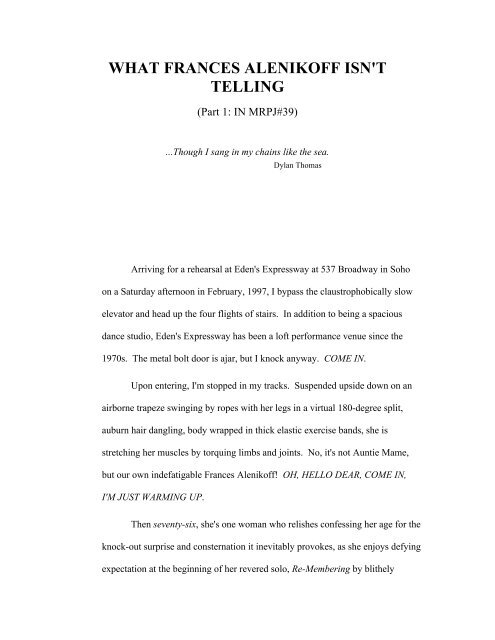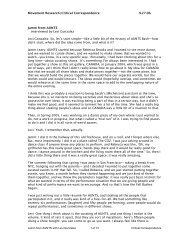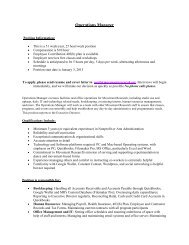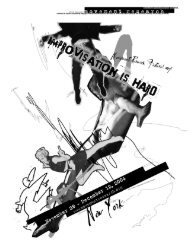WHAT FRANCES ALENIKOFF ISN'T TELLING - Movement Research
WHAT FRANCES ALENIKOFF ISN'T TELLING - Movement Research
WHAT FRANCES ALENIKOFF ISN'T TELLING - Movement Research
Create successful ePaper yourself
Turn your PDF publications into a flip-book with our unique Google optimized e-Paper software.
<strong>WHAT</strong> <strong>FRANCES</strong> <strong>ALENIKOFF</strong> <strong>ISN'T</strong><br />
<strong>TELLING</strong><br />
(Part 1: IN MRPJ#39)<br />
...Though I sang in my chains like the sea.<br />
Dylan Thomas<br />
Arriving for a rehearsal at Eden's Expressway at 537 Broadway in Soho<br />
on a Saturday afternoon in February, 1997, I bypass the claustrophobically slow<br />
elevator and head up the four flights of stairs. In addition to being a spacious<br />
dance studio, Eden's Expressway has been a loft performance venue since the<br />
1970s. The metal bolt door is ajar, but I knock anyway. COME IN.<br />
Upon entering, I'm stopped in my tracks. Suspended upside down on an<br />
airborne trapeze swinging by ropes with her legs in a virtual 180-degree split,<br />
auburn hair dangling, body wrapped in thick elastic exercise bands, she is<br />
stretching her muscles by torquing limbs and joints. No, it's not Auntie Mame,<br />
but our own indefatigable Frances Alenikoff! OH, HELLO DEAR, COME IN,<br />
I'M JUST WARMING UP.<br />
Then seventy-six, she's one woman who relishes confessing her age for the<br />
knock-out surprise and consternation it inevitably provokes, as she enjoys defying<br />
expectation at the beginning of her revered solo, Re-Membering by blithely
delivering, to great effect, her signature flash—an unabashed shoulder-high thrust<br />
kick.<br />
We were collaborating on a duet, www.alenikoffking.com, that we<br />
previewed the following month at <strong>Movement</strong> <strong>Research</strong>'s Monday Night series at<br />
Judson Church, and premiered a few weeks after that at Dance Theater<br />
Workshop's 30 th Anniversary Founder's Celebration. Both organizations grew out<br />
of the expansive 1960s ferment, a time of boundary-crossing and merging of arts<br />
forms. Mixed-means was on the cusp of becoming multimedia, and dance and<br />
theater suddenly seemed inseparable, the watershed decade before performance<br />
art.<br />
DTW was founded by Jeff Duncan, and at his last birthday party, in 1988,<br />
Frances was irresistibly riveting seated on a sofa flanked by its two other cofounders,<br />
choreographers Jack Moore and Art Bauman. A connection was made<br />
between us and we’ve been fast friends ever since.<br />
Frances’ past is legendary and details spill out around the edges of our<br />
rehearsals, talks, and phone marathons. Like many artists, she had a difficult<br />
childhood, with a demanding father and an enviably beautiful fashion model<br />
mother who appeared in movies, then later taught yoga, moved to California,<br />
became a spiritualist, and knew Aldous Huxley.<br />
During the 1940s, Frances began studying Afro-Haitian dance on<br />
scholarship at the Katherine Dunham School with celebrated dancers such as<br />
Syvilla Fort (an amazing woman, also one of my first teachers, for whom John<br />
Cage wrote the first piece for prepared piano).
Frances was championed and befriended by Doris Humphrey and Anna<br />
Sokolow during the 1950s for her chant dancing and independent quest.<br />
Josephine Baker, an elemental erotic phenomenon and gorgeous world-famous<br />
African-American performance sensation, hired Frances to choreograph for the<br />
Josephine Baker Show on Broadway in 1964.<br />
Frances was produced by Joseph Papp at the Public Theater, and<br />
confessed how dance writer Walter Sorell "tricked" her into becoming a dance<br />
writer for Dance News. She met Martha Graham in the dressing room during a<br />
cross country train trip when she was seventeen, and combed Graham’s hair and<br />
conversed with her for an entire day as Graham confided conflicts she had with<br />
“Miss Ruth”—Ruth St. Denis, another legend.<br />
Later Frances toured extensively with her multimedia concerts. She has<br />
taught, performed, and choreographed as far away as Hong Kong and Alaska, and<br />
was pulled into dancing in an ecstatic Vodoun ceremony in Haiti while on a group<br />
tour organized by Jacques d'Amboise, to the consternation of the tour guides and<br />
the delight of the natives. She danced in the Temple of Isis in Luxor on an<br />
Egyptian tour with Jean Houston's Mystery School.<br />
In June 1993, I saw Frances in a Mabou Mines studio production at PS<br />
122 in a play about poet Audre Lorde called Blood Summer Rituals, written and<br />
directed by Bill Wright. Frances played Lorde's charmingly authoritarian teacher,<br />
a Mother Superior, cloaked in an austere black habit.<br />
Instead of Frances the dancer, here was a distinctive actress with an<br />
uncanny presence and a perfectly modulated, dynamic stage voice—eloquent,
vibrant, and commanding. She has always been an intuitive performer with spunk<br />
and gusto. When I grilled her about what kind of training delivered up that voice,<br />
she confessed to not having had any.<br />
Well, not quite. An inveterate and captivating conversationalist, Frances<br />
brings several arts to the dance. Her voice is the key to her physicality, primarily<br />
through chant song, a primordially sprung vocalese that transforms lyrics into an<br />
abstract sonic mosaic that elides syntax or any specifiable language. As it gathers<br />
harmonic momentum, it mushrooms into a nameless deep song. “The voice<br />
energizes the resiliency of the dancing body.”<br />
Her staccato cadences of rubato overtones carry multiple emotive<br />
registers—joy, pathos, and mystery—while they capture the aural roots of<br />
different ethnic sources. She modulates and embellishes her transitions with<br />
deliquescent nasal resonances that twang and oscillate, unmistakably Oriental if<br />
not in fact Japanese.<br />
Her singing rides etheric currents whose surging rhythms erupt in<br />
explosive body movements that recall an Ur sprechen, glossolalia, or primeval<br />
patois. The vocables mix the frequencies of phonematic shards coincidental to<br />
any number of unfamiliar or lost tongues.<br />
The vocal spool activated by her breathing condenses and compresses a<br />
steady-state concatenation of kinetically textured transformations that move<br />
rapidly and mercurially through her body, mirroring the mysterious orders of<br />
nature's realms—elementals, sprites, spirits, archetypes, ancestors, and mythic<br />
beings.
A trigger moment illustrating that mastery occurred at the beginning of<br />
our duet, during her delivery of a poetically-laced monologue that evoked the<br />
fiery shamanic ceremonies of yore. In a split-second metamorphosis, she was<br />
forcefully transformed, as paroxysms of chanting initiated fluidly hieratic gestures<br />
and a flurry of fierce dramatic arm and leg movements that carried the dance<br />
through another threshold—to the ancestral whose mahamudras hold the keys to<br />
the mysteries.<br />
* * *<br />
Frances recently turned ninety-one, an event that augurs options for future<br />
generations. For years, I'd been researching material that informs dancers how to<br />
handle time and age—no small matter. And for decades she has been turning age<br />
on its head, subverting its preconceptions, making it an adventure. Younger<br />
dancers are struck by the fact that Frances is one of the few dance artists who has<br />
reinvented her art, her body, and her past, by transforming her lifetime’s<br />
experiences.<br />
At an Avant-Garde Arama performance at PS 122 in November, 1996,<br />
before a largely young, hip East Village crowd, she made being seventy-six a<br />
thrilling challenge as she worked the audience, dancing to hoots, howls, and<br />
whistles, licking her fingers with enticing bravura, flicking her tongue<br />
seductively, staring them down, laughing, slapping her thighs, daring and cajoling<br />
them with chutzpah simpatico to challenge their giddy, in-your-face excitement.<br />
One irrevocable source for her is the mythic and shamanistic—movement<br />
becomes a summoning, or incantation. Dance is ultimately mythical because it
delivers up a disembodied ethos transparent to temporality, connecting it with<br />
spiritual realms. Plato's parable of the cave attempts to penetrate the mysterious<br />
source of our represented world, but perhaps only the Buddhists have answered<br />
the comparable question of how sound and voice originated—they were emitted<br />
from the void behind the vortex of creation.<br />
While in Spain years ago, Frances visited the gypsies in the caves of<br />
Sacramonte, and was enticed by their passionate Flamencan musicians to sing and<br />
dance with them, and exuberantly won over even the most reticent. In her body,<br />
sound, movement, word, and image cohere as an inextricable matrix that informs<br />
and systemically transforms the synergy of artistic process.<br />
She and I have discussed how dancers can create their own mudras,<br />
magical gestures that can effect spiritual transformations and healing. The supple<br />
iconic positions of the fingers activate and intercept hyperdimensional vectors that<br />
release and stimulate the bioenergetic meridians surrounding the body, and can<br />
catalyze its magnetic and fluidic alignments.<br />
Magical, too, is how dance inhabits other realms. Gestures are agents of<br />
passage and metamorphosis. They precede childhood speech and manifest as<br />
prescient signs. When teaching dance composition, I focus on how gestures are<br />
the keys to implement and develop phrasing. Frances and I have enjoyed long<br />
conversations about the importance and compositional role improvisation plays in<br />
the development of dancer and dance.<br />
For Frances, movement embodies ritual ciphers that connect all forms and<br />
practices, evidencing how kinesis transmits an undertext of ephemeral inscriptions
iding on the currents and motor flexions of body impulses. The eye has to be<br />
primed to tune into perceiving their subtle intervals and dialectical<br />
transferences—between the visible and invisible, known and unknown, and self<br />
and other. At one especially memorable performance of Re-Membering, a<br />
matinee on a snowy wintry afternoon presented by The Field at Musical Theater<br />
on Lafayette Street in 1995, Frances was particularly attuned to the mystery of<br />
performance.<br />
As she lay on her side on the floor performing a section, about an injured<br />
one-winged bird she found on the beach and nurtured, she sinuously ambulated<br />
her limbs with a quicksilvery motivity. The movements suggested swimming, but<br />
the image took on an unusual eidetic otherness—the intrauterine passage between<br />
realms and convulsive peristalsis of the birthing channel.<br />
Frances and I continually mull over the complicated phenomenon of the<br />
mimetic, and how it operates while watching how a dance's intricate<br />
configurations unfold—how the virtual projection of images and qualities spring<br />
out of its plasticity and makes it deliver up the numinous. The mimetic is closely<br />
linked with the mnemonic, because memory resides as much in the muscles as in<br />
the brain.<br />
Unlike the literary arts or mime itself, the kinetics of movement exceed<br />
what is simply represented or symbolized as its semblances become fluid, liquid,<br />
and transparent. <strong>Movement</strong> entrains but surpasses the symbolic because its<br />
changing shapes reorder reality and unreality simultaneously. Dancing rides on<br />
semiotic currents and elicits images with multiple registers and gradients.
From one of Frances’ Performance columns in Craft Horizons: "But don't<br />
be misled by the term. Improvised dances are not usually just sessions of letting it<br />
all hang out. Most have a scaffolding which reflects the choreographer's goals<br />
and preoccupations and is fleshed out in performance by the dancers'<br />
temperaments and skills, combined with the specifics and urgencies of the<br />
performing situation. Methods are as varied as the people probing them..."<br />
For the dancer, the challenge of improvisation is to find ways to<br />
strengthen the connectivity of motor impulses and flexibility that control the<br />
coordination of spatial patterning necessary for interacting seamlessly with other<br />
bodies. For the choreographer, improvisation tests the limits of how the<br />
parameters of technique and composition can be deployed, the cohesion of<br />
structures generated with the radar necessary to engineer and test the qualities and<br />
tensities in performance.<br />
Improvisation supplies a hermetic key too: how to be both inside and<br />
outside the compositional process at the same time. Being a choreographer<br />
involves a curious dialectic of being embodied within the animating structures of<br />
a work, while simultaneously being outside of it to be able to see, conceive, and<br />
steer its development.<br />
* * *<br />
The idea that your walk contains the kinetic gestalt and cipher of your<br />
entire motor repertory is so patently obvious that dancers take it for granted, but<br />
what's taken for granted opens up when investigated and deconstructed. Before<br />
we began one of our work sessions, I reminded Frances about her unique walk,
especially its smooth sharp breezy distinctiveness punctuated by the bob and<br />
bounce of her hair, and I provoked her to use it in a dance. She looked at me with<br />
game bemusement.<br />
So all we did during our free form session was explore structural<br />
possibilities by walking—next to, behind, in front of, and around one another,<br />
sometimes very rapidly, sometimes gesturing while scurrying harriedly, cantering<br />
whimsically or fitfully between continuous and discontinuous synchronizations to<br />
keep up with or intercept one another.<br />
Sometimes we talked or laughed, riding or eliding impulses to gun the<br />
gain of the other's stride. Vocally we kept tripping the kinetic gears—movement,<br />
too, contains tropisms—by tricking the intervals between starting, stopping, and<br />
changing directions, and while also intercepting the delays created by quick<br />
changes. We turned and veered unexpectedly as we realigned the play between<br />
our gazes, gestures, and body facings, surprising one another as if we were on<br />
automatic pilot testing while mirroring the other's responses—almost before they<br />
happened.<br />
Even when we swerved off on tangents, we tried to monitor all the<br />
gradients of our double sets of reflexes to jump-start the uptake of kinetic<br />
continuity without breaking attention or taking time to check ourselves in the<br />
mirror. We used motion itself to gauge micro-intervals and coordinate the subtle<br />
layers of motor flexions contained within our irregular and sometimes fitful<br />
patterns in transit.<br />
* * *
Frances Alenikoff is also an accomplished writer whose dancing depends<br />
on a reciprocal dialoguing with her own and others' bodies to track and trace the<br />
intersections of systemic nuances. Her verbal skills are part of her articulatory<br />
prowess, and hone her choreographic mettle. For years she wrote about and<br />
reviewed dance in Dance News and Craft Horizons, kept extensive journals, and<br />
often incorporated texts and poetic monologues in her multimedia dances.<br />
Her dynamically evocative texts have an inimitable poetic knack for<br />
upbeat, lyrically incandescent non sequiturs laced with snappy plays of rhythm,<br />
hypnotic alliteration, and entendre. She is able to reconfigure and recontextualize<br />
the spoken modules from pieces such as Polyphrenic Bag Lady, Spider Woman,<br />
or Courtesan into new sharply defined dramatic vignettes by re-collaging their<br />
lines.<br />
She was commissioned by the Tribeca Performing Arts Center to perform<br />
a new solo tentatively entitled Sometimes ("Sometimes I think I'm a polyphrenic<br />
bag lady, a collector of shards to fashion mosaics...") in October, 2000. Her<br />
polyphrenia though is the oceanic passion of a hungry collector who embraces a<br />
plurivalency that subsumes a diversity of interests, images, and processes.<br />
The way her body’s somatic impulses burst, break through, and interrupt<br />
one another through movement, voice, and song build synchronistic confluences<br />
that mirror a tacit body language by utilizing the interstices to zap attention and<br />
theatrical continuity. She gathers up impulses as if they’re uniquely attuned<br />
digital sensors to expose intersecting vectors that give her performing physicality<br />
a high-alert readiness and casual charisma.
She dreamed of Demeter as a trespassed field targeted as fair prey<br />
for the stalking...<br />
Swinging between river and light,<br />
she focused the lens to clear her sight.<br />
Spying the crystal in the lucent night,<br />
Flamingo fawn born into dawn.<br />
She dreamed she licked fallow fodder into flaming flowers,<br />
impassioned blooms that blossomed after hours,<br />
transforming snake haunted jungles into bountiful bowers.<br />
She dreamed, she dreamed and dreaming, she dreamed<br />
that the thorns, themselves, sprouted lush flowers.<br />
If she listened quietly she could hear the sonata<br />
of the cerebral cortex, ringing harmonies with the medulla oblongata...<br />
As I mentioned before, Frances is as much an actress as a dancer.<br />
Theatrical smarts inform her every move. Sustained speaking while moving<br />
necessitates a different kind of breathing than dancing, but when both processes<br />
happen simultaneously, it’s a double challenge. Voice production is centered in<br />
the throat and solar plexus to require outward projection; dancing, though,<br />
involves an inward ‘under-breathing’ to secure enough oxygen for rigorously<br />
deploying the muscles in sustained motion.<br />
To speak and dance at the same time is taxing and involves utilizing the<br />
intervals to create an effortless delivery. Because dance is performative, its tacit<br />
dramatic element is challenged from moment-to-moment. Dancers who<br />
understand movement’s theatrical potential have the ability to let kinetic impulses<br />
continue their transit through the spine and into the head, that in turn generate<br />
emotive registers that are reflected throughout the entire instrument.<br />
So watching Frances work over an audience on opening nights,<br />
masterfully concealing the effort and activating voice and body simultaneously, is
always a surprise. She climbs atop a boxed platform one minute, then hits the<br />
floor and continues on her back and side all while moving, speaking or singing—<br />
quite an accomplishment! Even though time impinges on technique, age opens<br />
and fortifies being.<br />
And her poetic narrative, performed in highly distilled discrete sequences,<br />
functions discontinuously in performance. Her modes of mimetic variation<br />
transcend literality and linear development, the way a telephone line vibrates with<br />
several conversations at once. When we congratulate her after the performance,<br />
she reminds us that there will be many more octogenarians like her, but I remind<br />
her, not for a while, and hey, lucky us, we're talking to one now!<br />
* * *<br />
I initially posed the issue of age with Frances after reading Simone de<br />
Beauvoir's Coming of Age (the French title is, forthrightly, Old Age; Sophocles<br />
didn't write Oedipus Rex until he was 89—that got a laugh out of her). De<br />
Beauvoir: "...and it is this old age that makes it clear that everything has to be<br />
reconsidered, recast from the beginning. That is why the whole problem is so<br />
carefully passed over in silence; and that is why this silence has to be shattered."<br />
What is more mysterious than time passed and passing is perceiving its<br />
modes of fleeting inevitability. It resembles the mnemonic recollection of the<br />
world that your parents or grandparents inhabited, remote and hazily recollected<br />
through faded photographs obscured by blurs and watermarks, or like the tinny<br />
recording of an old radio program overlaid with crackling static. Stud Terkels's<br />
similarly titled book, Coming of Age, is also inspiring and mind-blowing, a
collection of older Americans sharing their unique, wide-ranging lifetime<br />
experiences.<br />
Dancers, on the other hand, are trained and programmed for disposability.<br />
Ballet companies often mandate retirement by forty. At that age, modern dancers<br />
are often just hitting their stride. Dance teachers restrict themselves to technique,<br />
not to the larger and longer-ranged physical challenges, and there is little<br />
literature on the subject. How muscles, skeleton, and system change with each<br />
decade, and how to reinforce the body against time's assault, is still a littleexplored<br />
no-man's land.<br />
Frances insists the first secret is: You have to find your own dance. In<br />
2000, <strong>Movement</strong> <strong>Research</strong>'s Performance Journal focused on the topic of age and<br />
cited the fact that the body begins aging by thirty-five. Thirty-five? HA!<br />
Thrilled, she consented to write something, and we held out for her secrets.<br />
Everyone wants to know how she does it.<br />
As she drafted sections of The Double Helix of Re-Membering, she'd read<br />
me tantalizing excerpts over the phone that zinged with poetic fervor, and<br />
prodded me for feedbacks and suggestions. Her words were lyrical, rhapsodic,<br />
and inspirational. But as the short-fuse deadline approached in the midst of a<br />
busy spring preempted by performances and deadlines, she was forced to abridge<br />
her original intention.<br />
She says she needs three more lives to do all the things she's already<br />
committed to do in this one, so someone else has to tackle the job! We laugh<br />
about the motto pinned over her desk: God put me on earth to accomplish a
certain number of things. Right now I'm so far behind I'll never die. Over which<br />
desk, I ask—New York or East Hampton? Both!<br />
Kenneth King is the author of Writing in Motion: Body—Language—Technology<br />
(Wesleyan University Press, 2003). His essay, War & The Sex Goddess: The Iraq<br />
War Meets Anna Nicole Smith, appeared in the Winter issue of The Rio Grande<br />
Review. Other recent essays have appeared in Hotel Amerika, /nor (New Ohio<br />
Review), and The Gay & Lesbian Review/Worldwide.







